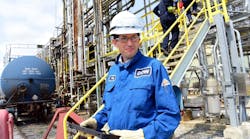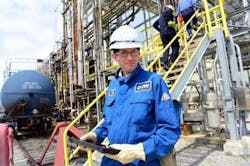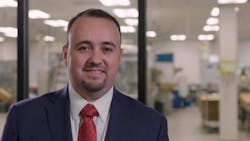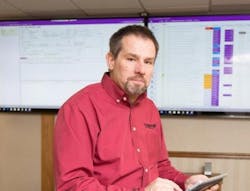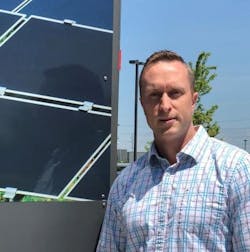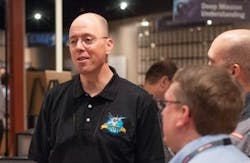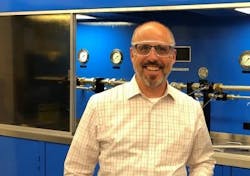By Keith Larson, Smart Industry Editor in Chief
The Smart Industry 50 program was created in 2016 to recognize and honor individuals across industry who were making a difference in their organizations’ pursuit and embrace of digital transformation. Nominations for this year’s class of 2018 were solicited from the readers of Smart Industry, from past recipients of this recognition, and from more than 20 editors across the Putman Media family of industry publications—journalists and engineers who have developed deep relationships with the various vertical niches and functional swaths that their communities of readers represent.
The full list of our fifty honorees is spread across the pages that follow, along with more in-depth profiles of many of them. We hope you find their personal stories as inspiring as we do, and join us in congratulating them on their accomplishments.
AGCO’s Peggy Gulick took an interesting path to her current role as director of digital transformation for the global leader in agricultural equipment and solutions. She started out studying English and art, but ended up in information technology. From there, she landed a job not in IT architecture or application development, but in the midst of an SAP deployment. It was there that she found her passion wasn’t for IT itself but for the processes that IT was created to support. “Studying processes and making them more efficient—I loved it,” she says.
A series of roles in IT and process followed, including global business process responsibility for Pure Fishing, a sporting goods manufacturer. “When I came to AGCO, it was a new position that merged the IT and lean teams,” she says. And now, with a new responsibility for global digital transformation, she’s working to spread the culture she helped develop at the company’s Jackson, Minn., facility across the company’s more than 40 manufacturing locations around the globe.
“We are extremely proud of the ‘informed reality’ tools we’ve developed for our assembly lines,” says Gulick of the company’s pioneering use of (Google) Glass hands-free headsets to convey electronic work instructions to operators who spend their days on a low volume, highly custom product mix. “Our assembly line is rolling four to six tractors a day—none of them the same,” Gulick explains. The wearable tools offer value immediately, Gulick says, crediting them for allowing faster training, the smoother introduction of process changes, and the ability to flag quality issues at the point of execution. “We use these technologies every day in production, making employees excel in all they do.”
But if the technology implementations are leading edge, the real secret to AGCO’s success is its focus on skilled workers. “It’s how we acclimate and embrace them,” Gulick says. “The successful application of new technologies is all about the adaptive culture we’re building. And once the culture transitions, our technology folks won’t be moving fast enough,” she predicts. “People who visit our Jackson facility find the projects are brilliant, but come away saying, ‘Wow, what a culture.’”
NEXT-GEN PROCESS TECHNOLOGIST
With responsibility for driving the implementation of new technology within Dow’s manufacturing organization, Billy Bardin is among those digital innovators who today are defining the future of process technology.
Dow Chemical’s Bill B. Bardin believes that digitalization and the IIoT represent a new generation of process technology advancement, much like the pneumatics that gave way to distributed control systems several decades ago.
According to Bardin, “Digitalization and the IIoT represent a new generation of process technology advancement, much like the pneumatics that gave way to distributed control systems several decades ago. The difference is that 35 to 40 years ago we were automating manual processes with new control technology, but with today’s digital and data science capabilities, we are in the position to advance process technology even further to deliver operational performance and products previously unconceived as well.”
Bardin’s no stranger to seeking out faster, more efficient ways to effect positive change in the organization, having helped steer the company’s efforts to bring the pharmaceutical industry’s “high throughput” research methodologies to the commercialization of new catalysts and materials. Advances that in the years since have yielded significant results not only in profitability but in energy savings and sustainable operations, too.
Looking forward, Dow promises to build an increasingly Digital Dow, with a digital thread across the company’s entire value chain. “The fun part of my job is setting us up for successful value delivery in the near-term, while establishing a path for the next 20-30 years that optimizes our manufacturing assets, data, and connectivity,” says Bardin.
From a production perspective, increasingly data-driven decision-making, together with plant optimization in real-time, top his future predictions list. His crystal ball also indicates the increased use of smarter, low-cost sensors and robotics—both of which promise to increase productivity and worker safety. Think sensors that can not only eliminate or reduce operator rounds but serve as an effective and reliable means for assessing potential equipment failures, and robots that can eliminate the need for hazardous and time-consuming confined-space-entry practices. “If they can use robotics for exploration of Mars,” Bardin says, “we can do it here, too.”
DIGITAL BLACK BELT
A master black belt in the Lean Six Sigma methodology, Carlos Ruiz learned early on in his career that new systems and process will only deliver results when people are at the center of the plan.
Over his career, Ruiz has successfully applied these principles in a series of increasingly responsible
A master black belt in the Lean Six Sigma methodology, Carlos Ruiz learned early on in his career that new systems and process will only deliver results when people are at the center of the plan. Today, he’s tasked with leading the manufacturing arm of global cosmetics powerhouse L’Oreal to be more consumer-centric: “We need the technology, systems and the mindset to respond more quickly to customer demand.”
positions in industries ranging from automotive to packaging to consumer packaged goods. Today, he’s responsible for manufacturing engineering and operational excellence in North America for L’Oreal, the global cosmetics powerhouse.
It’s hard to imagine a manufacturing industry more impacted by society’s digital transformation, or the extremes of “batch size one” mass customization. In the US, the company already manages over 1,200 new product launches annually, and Ruiz foresees a future in which the company must become ever more agile—able to pivot quickly to capitalize on a celebrity social-media mention of a nail polish shade, or to match an individual consumer’s skin tone (perhaps conveyed through a smartphone app) with custom foundation delivered in time for tonight’s cocktail party.
“Our mission is to accelerate transformation of manufacturing to be more consumer-centric,” Ruiz says. “We need the technology, systems and the mindset to respond more quickly to customer demand.”
Guided by the vision of Industry 4.0, the company’s digitalization effort started in earnest some 18 months ago, and North America has taken the lead across all global operations, Ruiz says. “We needed to augment our suppliers and vendors to keep the pace with the change, so our engineering team started co-developing the agile lines that will deliver the results needed by our business. At same time, we’re focusing on upskilling and training as a key objective. Our employees will be equipped with new capabilities and mindsets to embrace the new world of manufacturing.”
PATTERN WHISPERER
Speak even briefly to Jolene Baker about her work, and two things come clear quickly. First, she lives and breathes data; she’s passionate about rooting out patterns and the insights they reveal.
“Every bit of data is telling you something,” says Jolene Baker, senior manufacturing intelligence specialist for integrator and consulting firm LSI Logical Systems. “Data can come from instruments, humans, paper, nerves—many places,” she says. “Projects start with data and the people who give it to you—people’s interpretation of that data is important as well. That’s where I start.”
Success, however, comes for her when those insights can be used to effect positive change in the world—for example, by helping front-line workers to eliminate redundant, non-productive tasks, or using quality data as an early indicator of environmental issues for an oil & gas producer. She’s particularly invested in a project she’s working on now called WaterSMART with the Bureau of Reclamation and OSIsoft to build a community of water data stakeholders in the Western U.S. The goal of the project is a better understanding of water usage patterns and, ultimately, the coordination of more effective conservation efforts.
“Every bit of data is telling you something,” says Baker, who currently serves as senior manufacturing intelligence specialist for integrator and consulting firm LSI Logical Systems. “Data can come from instruments, humans, paper, nerves—many places,” she says. “Projects start with data and the people who give it to you—people’s interpretation of that data is important as well. That’s where I start.”
In the realm of data science, she sees the practice becoming easier in the not-too-distant future, so that the tools and insights they can glean are available to a broader range of people and industries. “If the market stays hungry for data, digital experts will continue to build tools that efficiently capture and simplify data analysis,” she says.
“There will be a logical meshing and compression of all the intelligent moving parts. Like in any other new technology, eventually there are fewer hoops, fewer components, and it becomes a new normal,” she says. “Pattern recognition will be an easy-to-do, every day activity.”
FOUNDATION BUILDER
Jay Gnuse came of age with the personal computer, turning a college gig tutoring staff at local construction company Chief Industries on the use of the popular Lotus 1-2-3 spreadsheet into a career that grew with the IT needs of the Grand Island, Nebraska-based company.
Founded in 1954, Chief Industries today boasts seven global divisions whose businesses range from
As agricultural equipment maker and construction contractor Chief Industries “turns to digital” to continue its expansion, it’ll also turn to IT Director Jay Gnuse to provide a resilient technology foundation and the new, digital tools it will need to further streamline logistics and distribution.
building agricultural processing equipment and storage facilities to operating ethanol plants. The number of computers Gnuse manages also has grown in the intervening years—from those first two IBM PCs to more than 850 today.
Throughout his time at Chief—as IS manager then IT director—Gnuse always sought to build cost-effective digital systems that reliably supported the growing company’s business objectives. Under his IT leadership, Chief Industries recently served as beta testers of enterprise software from its ERP provider, but he’s most proud of the strong, creative and fiscally responsible team he’s built. “We do a good job of satisfying user needs while keeping costs down,” Gnuse says.
But that’s starting to change as the company “looks to digital” not only to support current business processes but to enable further growth and efficiency gains. For example, much of his team’s recent efforts have been directed to modernizing and securing the company’s digital infrastructure in preparation for the future, an effort for which Cisco Systems recently awarded them a Technology Innovation Award for “improving business through digital transformation.”
“The shop floor is looking to automate, to make operations more efficient,” Gnuse adds. Imagine, if you will, thousands of construction components destined for multiple sites that have to be loaded onto trucks and timed to arrive at the right site at the right time—over projects that last weeks or months. “Logistics and parts tracking, likely using RFID, is what we’ll be working on soon.”
CLOUD OR BUST
From the start of his career at automotive Tier 1 supplier Dana Inc., Allen Blackmore was thrust into the world of manufacturing software and data analytics, where he soon earned a reputation for being able to stand up applications that could begin delivering value quickly. “Not all systems have to be huge,” Blackmore says. “You often have the opportunity to make an impact in a short time.” That reputation served Blackmore well, when the CIO of First Solar was looking to build a team to support the rapid scale-up of production at the photovoltaic systems supplier in the mid-2000s.
First Solar’s Allen Blackmore has worked diligently to move all of the company’s manufacturing data into the cloud to facilitate advanced analytics on manufacturing processes. The rest of the company’s data is next: “The next evolution for us is a data lake where we can bring in unstructured data. The cloud allows a new scale of analytics that is impossible with on-premise solutions.”
In his time at Dana and in his 12 ensuing years at First Solar, Blackmore has never seen himself as part of the IT cubicle culture. Rather, he sees his role as working closely with other parts of the business to educate them on what digital technology can do—and helping them to make it happen. “I love what I do,” Blackmore says. “I consider myself successful when I help others understand what’s possible, when I see that light bulb go off.”
Recently he’s worked to move all of the company’s manufacturing data into the cloud to facilitate advanced analytics on manufacturing processes. The next step is getting the rest of company’s data onto that same platform—sales, finance, everything. “As First Solar matures, the next evolution for us is a data lake where we can bring in unstructured data. The cloud allows a new scale of analytics that is impossible with on-premise solutions,” Blackmore says.
Blackmore’s clearly bullish on the power of analytics and on cloud technology, comparing the cloud to a puzzle that can be put together in multiple ways for value or cost advantages. The cloud may even be the ultimate solution to IT/OT convergence issues, he says. “Industry can collect data directly to the cloud,” he notes. “What if it took on 100% of the data? Security and performance are important attributes, of course, but what if OT gave up control?”
THE NON-INCREMENTALIST
Even as a newly minted chemical engineering grad, Steve Bitar saw his mission in life as finding better ways to do things. “I wanted to see step changes, not incremental gains—all I wanted to do was innovation,” he says. And when he learned that one of the new computers they had onsite at the Mobil refinery in Paulsboro, N.J., could be used move valves, he was hooked.
But this was the early 1980s, and some of the control applications he had been developing on the side ran up against a supervisor who—unbeknownst to him—had promised the refinery manager that the computers would not be used for control. Management came around in the end, but not before Bitar feared for his job. “It almost went terribly wrong,” Bitar says. Since that time, he’s worked at 13 different plant locations in the ExxonMobil organization and has learned that in conservative industries like oil refining, you have to be careful with respect to innovation. “Too much and you make people nervous.”
It was fitting, then, that Bitar ultimately found a home in ExxonMobil’s Research and EngineeringBut Bitar’s biggest innovation likely remains ahead of him. Starting in 2012, he took up the company’s initiative to figure out a way to make modernization, migration and lifecycle management of the company’s fleet of distributed control systems (DCS) a less painful proposition. That initiative resulted in the Open Process Automation Forum, an industry-wide initiative designed to develop a more open architecture that would ultimately allow the continuous evolution of on-process control systems technology—without the need for extensive, multi-year updates. “We’ll upgrade as a matter of course,” Bitar predicts, “adding compute as needed and unlocking innovation along the way.”
THE EDGE OF TRANSFORMATION
Ask Irene Petrick and Faith McCreary about the work they do at Intel, and it’s easy to see how the duo found each other “at the edge of transformation,” studying the factors that influence how readily industrial organizations embrace digital technologies—and what can be done to ease that transformation’s disruptiveness for the individuals involved.
Petrick and McCreary bring complementary perspectives and experiences to the task, which perhaps explains why their collaboration has been as productive as it has. The pair recently published the results of a six-month joint research project in which they examined the role-based differences likely to influence acceptance of IIoT technologies, obstacles to change for both manufacturing workers and leaders, and leadership strategies for accelerating the transition to the intelligent factory of Industry 4.0. (The two presented the results of that study at the Smart Industry 2018 conference.)
A human factors engineer by training, McCreary’s study of mathematical modeling—“I loved the patterns”—ultimately brought her to NASA’s Jet Propulsion lab, where she worked on the human side of deep space navigation. Then it was on industrial and systems engineering, where she studied how technology is introduced into organizations. She’s currently a principal engineer and user experience researcher in Intel’s Internet of Things group.
Petrick took a similarly circuitous path to her current role as director of industrial innovation in the company’s IoT group. She started in business and economics, but she wasn’t quite satisfied with how the models used in these fields often require one to “assume away reality” in order to make them work. She then turned to industry where she studied manufacturing strategy from both technology and business perspectives with a focus on innovation. A stint in academia including a broad range of industry collaborations led to a project for Intel, “and when they asked me to stay, I said ‘yes,’” Petrick says.
Both McCreary and Petrick are fascinated by the opportunity to better understand the complex landscape that characterizes the digital transformation of industry. “You can’t look at one aspect and understand what’s happening,” says Petrick. “It’s technology, people and the environment in which they meet.”
Clearly, factories of tomorrow will be more autonomous than they are today, and McCreary and Petrick are seeking to help companies understand where their operations fit in the spectrum of future possibilities—and how they can best get there.
“It’s very satisfying to do research that is both interesting and useful,” adds McCreary. “And we’re finding that sweet spot.”
CAPTIVE VENTURE CAPITALIST
How does a large, multinational company tap into and leverage the creative ideas of its people when its more than 83,000 employees are spread across more than 40 countries around the globe?
“We often say we don’t have technology problems, we have awareness problems.” BAE Systems’ John Kelly has led the development of Empower Innovation, a digital platform to coordinate and encourage innovation across the organization’s 83,000 employees regardless of role or geography, and to evaluate and nurture the most promising ideas.
If you’re BAE Systems, you tap John Kelly to build a digital platform to coordinate and encourage innovation across the organization regardless of role or geography, and to evaluate and nurture the most promising ideas. Called “Empower Innovation,” the organization Kelly today directs is equal parts crowd-sourced idea management system and internal venture capital fund. “Our mission is to engage our workforce to solve problems and to develop new capabilities,” he says.
Empower Innovation was created in large part to make more accessible the often isolated pockets of expertise common to any large organization, Kelly explains. “We often say we don’t have technology problems, we have awareness problems.”
Kelly spent ten years at the U.S. Dept. of Defense before joining BAE Systems 15 years ago, and has spent much of that entire time focused on the rapid development of complex, innovative systems. One notable initiative that came out of the company’s Empower Innovation process is the development and scale-up of mixed (augmented) and virtual reality systems that are easier and more efficient to develop and use.
The company partnered with PTC and Microsoft to develop “guided work instructions” to both bring operators up to speed quickly, and to assist them during actual assembly operations of complex battery systems. “Training time is down 40%, and assembly time is down 50%,” Kelly says of efficiencies gained using the mixed reality tools. The company also has used mixed reality in critical design reviews with clients to help them understand complex issues quickly, and full virtual reality in the design of factory-floor layouts. “We’ve saved significant time and money,” Kelly says.
Currently, BAE Systems is working to link the guided work instructions that its operators use on the floor all the way back to its CAD/CAM systems, so that when a design change is made it’s propagated all the way down the chain. Consider that as many as 5,000 individual components may be involved in one finished product’s assembly, and this task reveals itself as clearly nontrivial. “The ‘PDF on glass’ is the standard today,” Kelly adds, “but now we’re aiming to create a living, breathing link from the digital to the physical.”
Kelly also believes that the sort of information-sharing that BAE Systems is aiming to facilitate among its employees will someday soon take the shape of public, “flat-earth” access to domain expertise wherever it exists around the world. Competitive advantage will shift from large companies and academic institutions, with specialized know-how well publicized and well shared around the world, enabled by a global high-speed data fabric. “The winners will be organizations that can best understand customer needs and rapidly compose solutions.”
FROM CONCEPT TO REALITY
Graduating from college into the teeth of the oil price shock and early 1990s recession that dampened job prospects in his native Texas, Jeff N. Smith took a flyer: he moved to the Big Apple and soon was swept up in the burgeoning tech boom—first working for publications covering this exciting new frontier, then for a series of tech start-ups.
The one key constant in his early career was change itself, Smith says—a willingness to embark on
Jeff Smith prides himself on his ability to digest risk in order to place a claim on the future. That outlook has led him from a start-up exchange for carbon credits to now steering the IoT fortunes of Parker Hannifin, the 100-year-old maker of industrial components that go into machines ranging from submarines to spaceships. He’s educating the company’s 150 divisions and more than 300 companies on the financial and technical realities of digital transformation.
uncertain paths and to build from the ground up, often from scratch. “I’ve always been willing to digest risk in order to place a claim on the future.”
Indeed, Smith found that nursing a new business concept from idea to reality—then finding customers who could benefit from that new offering—was particularly fulfilling and satisfying. He points to a smart grid technology solution that he helped take all the way from whiteboard to deployment at hundreds of locations across four continents. “It’s really made a difference in their lives,” Smith says.
That passion is serving Smith well in his current role as business development lead for Parker Hannifin’s central IoT team. In that position, he’s responsible for helping the $12 billion component manufacturer discover how the new world of connected products and services can be applied to the seven groups, 150 divisions and more than 300 diverse companies that make up the Parker Hannifin organization.
“This year, Parker Hannifin celebrates a hundred years of making components that go into other companies’ products—from submarines to spaceships,” Smith notes. “We have some plants running 24/7 to meet demand, which can make it hard to treat the IIoT a priority. To have meaningful conversations, I have to boil the IIoT down into its primary colors—the what and the why of the IIoT.”
BUILDER OF THE IOT WORKFORCE
Trent Salvaggio has a uniquely broad perspective on the Internet of Things. As executive director of the IoT Talent Consortium, he leads the non-profit consortium of industry, government and academic organizations in its effort to “inspire, create and grow the organizations and workforces needed to drive IoT-enabled digital transformation across every sector.”
Before joining the IoT Talent Consortium, Salvaggio led an array of commercial digital transformation efforts ranging from outsourcing logistics to payroll processing. In each case, what was needed was “execution on initiatives across widespread, diverse organizations with multiple cultures,” Salvaggio says. “The common theme in my experience is bringing together teams—finding out who has the right skills, who has the right education and bringing them together.”
In his current role, Salvaggio is working to coordinate the efforts of academia, industry and government across a variety of verticals, each of which is at different stage with a different set of problems—from smart cities to smart healthcare to smart factories. “Keeping up with change across such a broad swath of society is a real challenge,” Salvaggio confesses. “Often, a big challenge is not knowing what we don’t know.”
One of his key tasks lies in understanding and predicting the future of jobs and work, and one thing’s for sure: it’s not in repetitive tasks, Salvaggio says. “Digital transformation is being driven by human ingenuity.” The future won’t be about specialists, but about generalists who can work as part of a team. “It’s time to look at everything, challenge everything,” he says. “Success will be a different type of worker.”
Salvaggio is particularly proud of the work the IoT Talent Consortium has done in the realm of education, such as helping MIT to develop its Internet of Things curriculum. Plenty of work remains, however, as indicated by the ongoing disparity between academia assessments (high) and employer assessments (low) of graduating student preparedness.
And while the challenges are daunting, Salvaggio’s excited to be able to positively impact workforce preparedness on such a large scale. “I’ve got the best job in the world,” he says.[sidebar id="1"]
MIXED MARTIAL ARTIST-IN-TRAINING
Alan Amling, who today serves as vice president of corporate strategy for UPS, exemplifies the life-long learner. A 26-year employee of the global leader in logistics, he’s now back in graduate school, seeking to help UPS remain as innovative and relevant in today’s increasingly digital economy as it has been for the first 111 years of its existence.
“My dissertation is exploring threat recognition in incumbent firms—the process of moving from knowledge to action,” Amling says. “My aim is to expand the boundaries of the disruptive innovation theory of Clayton Christensen—who is on my dissertation committee—and provide guidance to UPS and other companies hoping to avoid their own ‘Kodak Moment.’ I’m two and a half years into that journey and going through the most intense learning period of my life.”
Amling graduated college (for the first time!) with a double major in business and psychology, but after a few years at forest-products company Weyerhauser realized he would need to augment these softer skills with the hard skills of finance, economics and operations to advance. After completing his MBA, he thought he would join a marketing-focused company like P&G or Nestle, but interviewed and took a job with UPS when they came to campus. “I moved from an industrial engineering group to the marketing strategy group at the corporate office, and begged to join a special assignment team looking at how the internet would impact commerce….and it was off to the races!”
“Professionally, I’m very focused on helping UPS make the jump from the industrial economy to the digital economy, from a supplier-centric supply chain to a consumer-centric supply chain, and from ‘the tightest ship in the shipping industry’ to one that is also highly adaptable and agile.”
But that path forward is anything but clear, says Amling, referencing a recent dissertation discussion with Christensen. “He told me that it would be a great contribution if I could help companies see that the most important information to their future survival is the information that has not been created yet,” Amling says. “Consequently, my prediction is that today’s method of looking at the past to predict the future will be, well, a thing of the past.
“I like the analogy that the industrial economy is like playing chess and the digital economy is more like mixed martial arts. If you expect the right hook based on past experience, you open yourself up to being kicked in the head. Being highly agile and adaptable will rule the day.”
The Smart Industry 50: Class of 2018
Alan Amling, UPS—VP Corporate Strategy
Jolene Baker, LSI Logistical Systems—Senior Manufacturing Intelligence Specialist
Billy B. Bardin, The Dow Chemical Company—Global Operations Technology Director
From his early days crunching revenue forecasts for big-budget Hollywood films, Parag Vaish has long practiced making disciplined, de-risked decisions based on limited information. Today he’s in charge of consumers’ digital relationship with the Tesla brand, including their electric cars and home energy solutions—and helping to advance the company’s mission to “accelerate the world’s transition to sustainable energy.”
Dean Bartles, University of New Hampshire—Director, John Olson Advanced Manufacturing Center
Crystal Bettinger, Westar Energy—Supervisor of Predictive Maintenance
Steve Bitar, ExxonMobil Research & Engineering—R&D Program Manager
Allen Blackmore, First Solar—Solutions Architect, Business Intelligence
Randal “Scott” Carter, Georgia-Pacific—VP Automation Innovation
Sanjay Choubey, Briggs + Stratton—Global Digital Strategy & Transformation Leader
Ted Colbert, Boeing—CIO, SVP IT & Data Analytics
Neil Crockett, Rolls-Royce Group—Chief Digital Officer
Paul Daugherty, Accenture—Chief Technology & Innovation Officer
Thomas Doney, Nestle Development Center—Expert Engineer
Michael Dudzic, ArcelorMittal Dofasco—General Manager, Industrial Automation
Jim Fowler, VP & Group CIO—GE
Newell Franks, Burr OAK Tool—Chairman, CEO
Tom Gaasenbeek likes to say he is “always up to something.” For example, he came to the early realization in 1994 that all machine tools should be connected to the internet, and celebrates November 11, 2000, as the day the world settled on XML as the standard way to do just that. Among his industry contributions is his work on the OMAC XML effort that ultimately led to MTConnect, the increasingly accepted standard now being used to allow machine tools to participate in the Industrial Internet of Things.
Tom Gaasenbeek, Nexas Networks—CEO
Dan Gamota, Jabil—VP Engineering & Technology Services
Jay Gnuse, Chief Industries—Information Technology Director
Jens Gralfs, Airbus Group—VP Research & Technology
Matt Griffiths, Stanley Black + Decker Industrial—CIO
Peggy Gulick, AGCO—Director, Digital Transformation, Global Manufacturing
Edith Harmon-Weiss, New Balance—VP Manufacturing Innovation
Ahmed Hashmi, BP—Global Head, Upstream Technology
Chris Heck, Duke Energy—CIO
Julie Holstad, Southern Company—Engineering Manager, Data Acquisition & Cyber Security
Michael Hurley, Flint Hills Resources—CIO
Brian Hurst, Exelon Utilities—Chief Analytics Officer
John Kelly, BAE Systems—Director of Empower Innovation
Don Kinard, Lockheed Martin—Senior Fellow
Greg Leveille, ConocoPhillips—CTO
Since leaving business school in the 1993, Altimeter’s Charlene Li has felt most at home in the midst of digital transformation. So much so, that she wrote the book. Look for "The Disruptor’s Agenda: How to Create a Strategy for Breakthrough Growth" at bookstores and online coming in February 2019.
Charlene Li, Altimeter—Principal Analyst
Dale Malony, Honda of America—OT & Asset Monitoring Leader
Faith McCreary, Intel—Principal Engineer & User Experience Researcher
Laura Merling, UTC—Chief Digital Officer
Rolf Paeper, Ingersoll Rand—VP Digital Solutions
Irene Petrick, Intel—Director Industrial Innovation, IoT Group
Allison Radecki, Beam Suntory—CIO
Chris Renken, Constellation Brands—VP Manufacturing Systems
Gavin Rennick, Schlumberger—President, Software Integrated Solutions
Carlos Ruiz, L’Oreal—Senior Vice President, Manufacturing North America
Trent Salvaggio, IoT Talent Consortium—Executive Director
Vivek Sankaran, Frito-Lay North America—President, COO
Didier Sassereau, Gebo Cermex—Product Manager
Narinder Singh is leading the efforts of global agribusiness leader Olam International to define the strategic roadmap for manufacturing operations and procurement that will deliver Olam’s vision to be “the most differentiated and valuable global agri-business by 2040.” Across the company, he is working with diverse, multifunctional teams—including both “digital dinosaurs” and Millenials—to evaluate those transformations that are most important to the company’s future, anticipate digital disruption to get benefits of early mover status, and establish a digital culture for the future.
Narinder Pal Singh, OLAM International—VP Engineering
Jeff Smith, Parker Hannifin—IoT Business Development
Yves Gorat Stommel, Evonik—Director, Business Development & Innovation
Derek Travella, Monsanto—Reliability Systems Lead
Parag Vaish, Tesla—Head of Digital Product Management, Content & Design
Steve Zitney, U.S. Dept. of Energy—Process Systems Engineering Research
